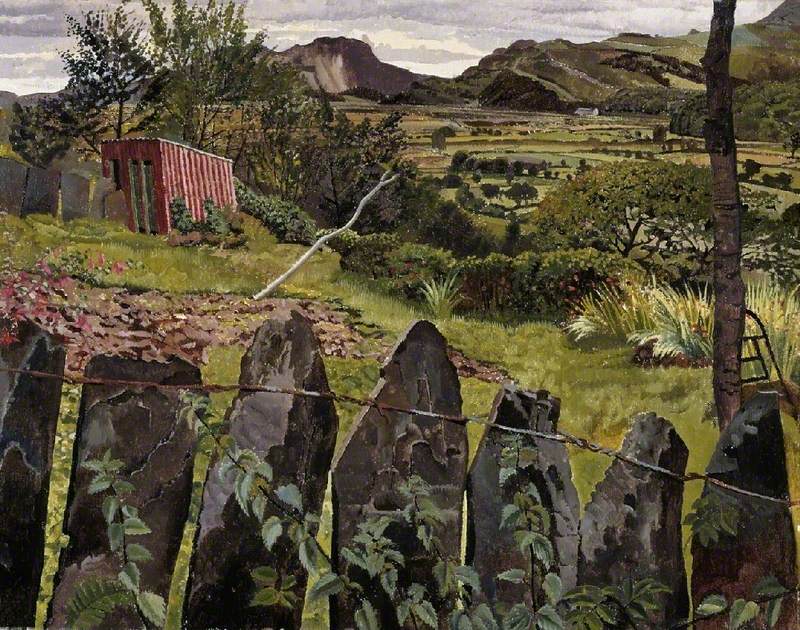
1938 was a difficult year for Stanley Spencer. His marriage to his wife Hilda Carline had been in trouble for years. Divorce followed in 1937, though the two never lost contact. His relationship with the artist Patricia Preece, whom he’d met in 1929, had been close and obsessive – he commemorated it in several nude portraits – but was now turning sour. She and Spencer married, a week after the divorce, but she was more interested in her lover Dorothy Hepworth (whose paintings she passed off as her own). By the end of 1938 Patricia would cause him to leave Cookham, the Berkshire village where he’d been born and the source of so much of his artistic inspiration, and to move to London. He’d unwisely made over his house and his finances to Patricia, and was also under the mistaken impression that he’d be able to maintain a ménage à trois with Hilda and Patricia. Oversexed but uncomprehending, he was at a loss.

In early September Spencer decided he needed to get away, and immediately thought of Hilda (they hadn’t seen each other since he painted her, shortly after their divorce, in 1937). Hilda and her mother were staying in Eryri, in the village of Llanfrothen, with a friend, Mrs Johnson, and he invited himself to join them, at some date before 7 September. There’s no record of what happened in Llanfrothen (did Spencer, for example, meet the architect Clough Williams-Ellis, who lived close by in Plas Bondanw?). By 14 October he was back in Cookham. But his stay in Wales was long enough for him to produce two landscapes, in oil on canvas, of the countryside he was living in.
For good reason Spencer is mainly associated with Cookham, Berkshire and neighbouring counties, and so is generally regarded as a quintessentially English artist. But it’s clear that he immediately appreciated the special qualities of the Eryri landscape, so different from the homely and domestic world of his Thames-side home.

The more striking of the two Llanfrothen paintings, now in the Fitzwilliam Museum, Cambridge, is entitled Landscape in north Wales. The view takes in a garden, possibly at the back of the cottage or house where Spencer was staying, and in the distance, across the plain of the river Glaslyn to the south-west, is Moel y Gest, the hill to the west of Porthmadog. In the foreground is a fence made of upended leftover slate slabs (‘crawiau llechi’) held in place by wires. Spencer knew that this feature was highly characteristic of the slate areas of Gwynedd – the practice goes back to the late eighteenth century – and that it would immediately situate his painting in space. It also acts as a strong anchor to the picture’s composition. The other main anchor, in the middle left of the picture, is a tin garden shed with sloping roof, that leads the eye down the slope to the plain in the distance. It takes a while for the eye to return to the foreground and notice that Spencer, in his characteristically hyperrealist manner, has carefully arranged a row of stinging nettles in front of the slate slabs.

The second painting, Snowdon from Llanfrothen, in Amgueddfa Cymru – National Museum Wales, is a more conventional picture. The view this time is to the north-west. Below the fields in the foreground is the Glaslyn plain again, and beyond, Moel-ddu and and other hills, with the peak of Yr Wyddfa, garlanded in cloud, away to the far right. What Spencer emphasises, again, is the human impact on the landscape, in particular the stout stone walls surrounding the fields.
It never pleased Spencer to think that the public preferred to buy his landscapes rather the more imaginative figure paintings that meant more to him. In the second half of the 1930s, when he need the money more, his landscape output increased a great deal (to decline again once he started to be commissioned by the War Artists’ Advisory Committee during World War II). The work often bored him: ‘when for one or two or five or seven weeks I stand on one patch of ground I begin to feel something of what a post in the ground just by me feels.’

But that’s not to say that he didn’t take care when working on his landscapes, or that he felt nothing for them. ‘My landscape painting’, he said, ‘has enabled me to keep my bearings. It has been my contact with the world, my soundings taken, my plumb line dropped.’ That’s not quite, perhaps, the formulation he’d have used about the Welsh paintings. Llanfrothen introduced him to an unfamiliar country and challenged his normal landscape practice. Landscape in north Wales in particular shows he responded to the challenge with ingenuity and sympathy.
It’s interesting that when the publishers of the collected poems of R.S. Thomas were looking for an illustration to place on the book’s cover in 1993, they chose Landscape in north Wales. (Even if they did inadvertently reverse the image.)


Leave a Reply